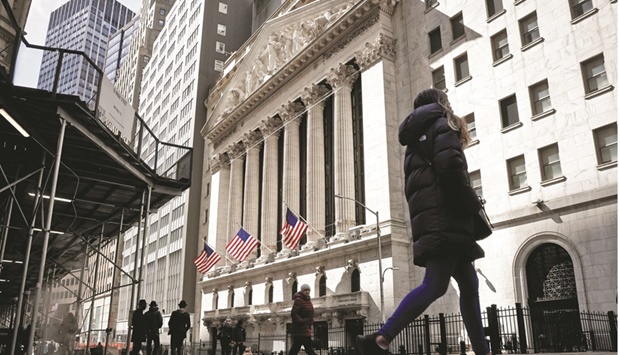Side-by-side declines in US equity and fixed income markets are pushing investors into cash, commodities and dividend-paying stocks as geopolitical uncertainty and worries over a hawkish Federal Reserve rock asset prices.
With the first quarter of 2022 winding down, the S&P 500 is down around 5% year-to-date, after falling as much as 12.5% earlier in the year.
The ICE BofA Treasury Index, meanwhile, was recently down 5.6% this year, its worst start in history.
Investors have traditionally counted on a mix of stocks and bonds to blunt declines in their portfolio, with stocks ideally rising amid economic optimism and bonds strengthening during times of uncertainty.
That strategy can go awry, however, and market gyrations stemming from Russia’s invasion of Ukraine, soaring commodity prices and the Fed’s hawkish tilt have combined to make it harder to follow the playbook this time around.
Though a sharp bounce in stocks has more than halved the S&P 500’s losses for the year-to-date, some investors are wary the rebound may not last and are seeking to cut their exposure.
“We are in a perfect storm right now,” said Katie Nixon, chief investment officer for Northern Trust Wealth Management. “We’ve been in periods of heightened geopolitical risk before but this one feels a little different.
The negative outcomes could be much more severe and broad.”
Nixon is increasing stakes in agricultural and energy companies, as well as real estate investment trusts (REITs), which have acted as an inflation hedge in the past.
Investors moved $13.2bn to cash and $2.1bn to gold over the last week, data from BoFA Global research showed.
US stocks saw $3.1bn in outflows, their largest in nine weeks.
The firm’s latest survey showed fund managers’ cash positions earlier this month at their highest since March 2020.
George Young, a portfolio manager at Villere & Co, is raising his portfolio’s cash allocation to nearly 15%, well above the typical 3% of assets he normally holds.
“Cash is paying literally nothing and is arguably negative because of inflation, but we’re not seeing many things that we want to buy,” he said.
Recent declines have “been more painful than many prior bouts of volatility” due to the twin sell-offs in both stocks and bonds, wrote Michael Fredericks, head of income investing for BlackRock’s Multi-Asset Strategies Team, in a note Friday.
He is growing more bullish on dividend-paying stocks, which trade at lower forward price to earnings valuations than the broad S&P 500, and are less sensitive to rising interest rates than growth stocks or bonds.
Gains have been particularly hard to come by in the bond market, as investors recalibrate their portfolios to a Fed that appears ready to go all-out in its battle against inflation.
Yields on the 10-year benchmark US Treasury, which move inversely to bond prices, reached a three-year high of around 2.5% in the past week, with investors now pricing in more than 200 basis points of interest rate tightening this year.
With few attractive opportunities in US debt, Anders Persson, head of global fixed income at Nuveen, has recently increased his positions in dollar-denominated emerging market bonds, in part due to the rally in commodity prices.
“There is not a clean play-book for a post-pandemic Fed pivot at the same time you have a war between Ukraine and Russia,” he said.

People are seen on Wall Street outside the New York Stock Exchange. Side-by-side declines in US equity and fixed income markets are pushing investors into cash, commodities and dividend-paying stocks as geopolitical uncertainty and worries over a hawkish Federal Reserve rock asset prices.


